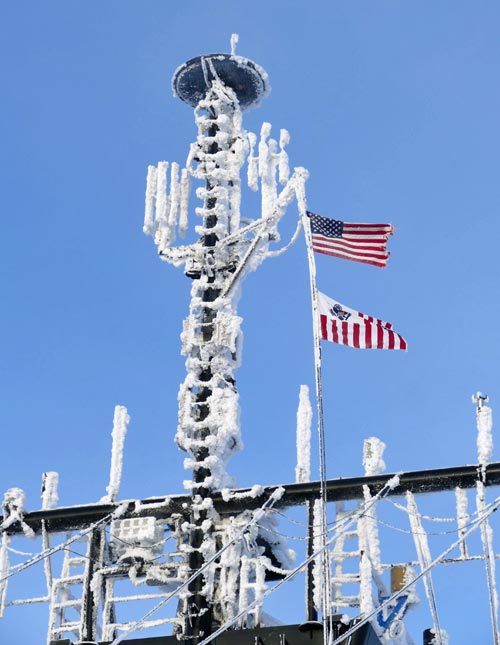Cruise Day 42
Speed 0 knots (kts) (on station)
Course n/a
Location N. Canada Basin, ~451 nautical miles south of N. Pole
Depth 3458 m
GO DEEPER DISCUSSION: (see previous journal for the questions.)
Both benthic and sea ice life zones offer surfaces to live on (or in), differing from various open-water habitats that lack any such structure. In many ways, sea ice is like an inverted benthic (sea floor) environment. The clearest difference is depth – sea ice will always be floating and therefore shallow, while benthic zones begin shallow (just beyond the tidal zone) and extend to the incredible depths of deep sea trenches. Tied to this is light – sea ice is in the photic zone (where light reaches), but only shallow benthic environments get light while most of the sea floor is perpetually dark. There’s another similarity, this time with the deep benthic and the sea ice zones: Both are cold. Deep water throughout the world’s oceans is cold because dense polar water sinks and spreads throughout the bottom of ocean basins. Shallow benthic zones are generally warmer than the sea ice zone except in polar regions, with temperatures highly dependent on surface currents and latitude.
TODAY’S JOURNAL:
After a sequence of sampling operations that ran all night and through mid-morning, we slightly re-positioned to gain access to a nearby floe to begin an ice station. We’re now essentially at the foot of the Alpha Ridge in the northern part of the Canada Basin, one of the Arctic Ocean’s major abyssal plains. It got quite cold last night, reaching 4° F, causing a thick shaggy layer of ice crystals to form on exposed surfaces. Now it is sunny and brisk at 8° F with only light breezes. Folks are gearing up for the ice, knowing that this might be our last chance at an ice station as we progress south. My friend Chris Marsay spotted movement out on the ice when he was checking the aerosol sampling gear, and it turned out to be an arctic fox! I tried for it but it was gone, but I’ll be keeping my eye out to see if it (or a polar bear it may be following) returns.


Sample analysis is an ongoing process in the various lab spaces and science vans, and yesterday Zoe Wambaugh, a masters student at Old Dominion University, Virginia, was kind enough to show me her setup for analyzing arsenic. Zoe is working in a large walk-in refrigerator, not because she needs a cold room but because additional lab space was needed (the refrigerator is turned off in case you were worried about her staying warm.)

To quantify arsenic in water samples, Zoe begins by converting different forms of the element into arsenic hydride, a gas at typical lab temperatures. The tiny amounts of arsenic hydride gas produced are carried out of the sample by helium, chosen for its inert properties and extremely low condensation temperature. It first passes through a cold trap where any water vapor condenses, leaving only dry helium and the arsenic hydride. The remaining gas then goes through tubing packed in glass wool that is immersed in liquid nitrogen. The extremely low temperature of the liquid nitrogen (−195.79 °C) causes the arsenic hydride to condense on the glass wool while helium (which condenses at -269° C) continues to pass through.

Once the condensing process has run its course the trap is removed from the liquid nitrogen, causing any captured arsenic hydride to change back to a gas. This gas is analyzed using a technique called gas chromatography. Perhaps you’ve done an experiment by drawing a line on a piece of filter paper with a black marker and putting rubbing alcohol on the end of the paper. As the alcohol soaks through the paper it carries different pigments along, separating them out at different parts of the filter paper to see what colors go into the marker. Gas chromatography is a sophisticated version of the same idea, with different substances in the gas being analyzed sorting out at different times in a separation column within the instrument. A computer produces graphed peaks for the various substances detected, and by measuring the size of the arsenic peak, a concentration for the sample being analyzed can be derived.


Arsenic is an interesting element – it has biologic pathways within marine ecosystems and may even be essential to organisms like phytoplankton in tiny amounts, but in larger amounts is toxic. The measurements being taken on the 2015 US Arctic GEOTRACES expedition will provide an important baseline of data for this trace metal in the Arctic Ocean.
GO DEEPER!
What can an arctic fox find out on the sea ice to eat?
Aloft Con web cam updated every hour
Healy Track
That's all for now. Best- Bill


Comments